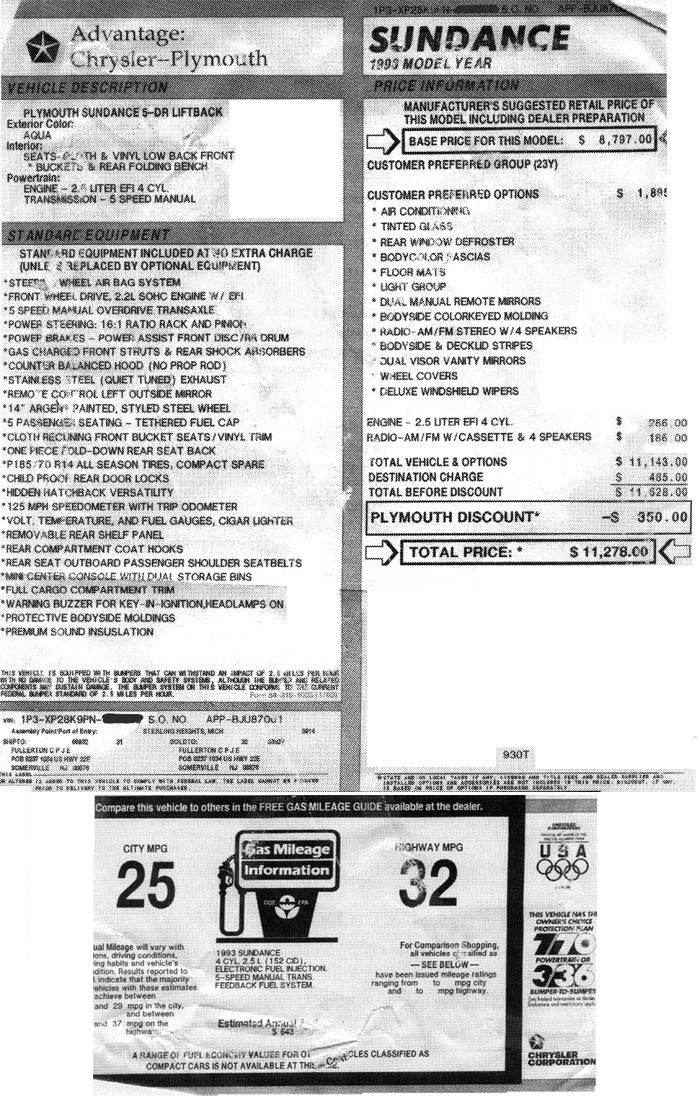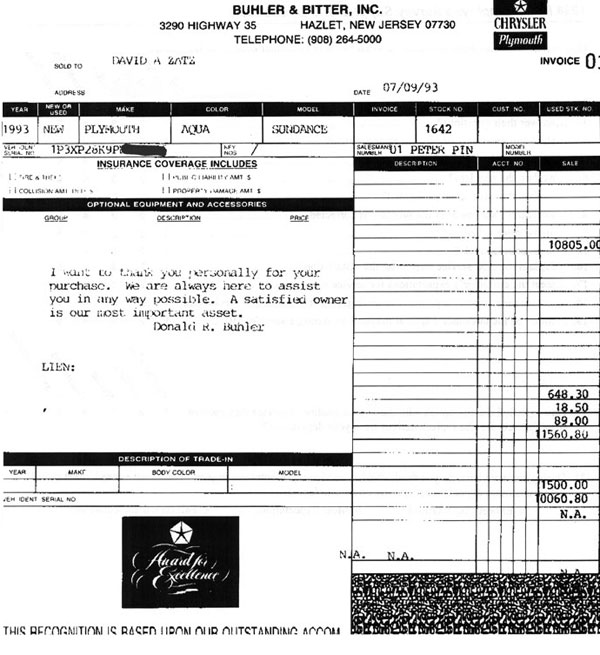Our story about the history of the Monroney (price sticker) guided readers through the various options, packages, and so on. Today we are doing the same thing, but the car is 23 model years newer—a Plymouth Sundance, along with the nearly-identical Dodge Shadow the final new car made from the stretched and prodded K architecture. Technically the “P” bodies used a new platform based on a shortened Spirit/Acclaim, using Daytona-like suspension tuning for a sportier feel.

I bought this particular car, owning it for years without actually photographing it. At one point it was crashed by Chrysler of Paramus’ body shop, badly repaired, badly re-repaired, and fully repainted twice (without getting washed first either time); it ended up being sold off with the new paint peeling. Buying this car was far more pleasant; it came from Buhler & Bitter of Hazlet, New Jersey, then one of New Jersey’s best two dealerships for service and probably the best in the state for sales.
The original sticker went with the car when I sold it, but I kept a copy. The description section shows that it had Chrysler’s 2.5 liter, with a single-point electronic fuel injection setup; the base engine was the similar, shorter-stroke 2.2. You can see the option on the right—the 2.5 cost $286. In return for that the driver got more grunt and better low-end responsiveness.

You can see that the fuel economy was 25 city, 32 highway, using the relatively generous (compared to 2008 and newer) testing of the time. This was not especially good for the time, and the 1995 Neon, released in early 1994, would be rated at a much better 29 city, 38 highway, despite running a much faster 0-60 time. The base 2.2 had slightly better mileage with the five-speed manual transmission. The three-speed automatic caused a definite hit to both acceleration and gas mileage. Buyers wanting more power could opt for a 3-liter Mitsubishi V6.
The car was painted in Aqua, a bright, attention-getting metallic paint; the interior had hardy, stain-resistant gray cloth seats with vinyl on the sides. The rear bench seatback folded down to provide a pass-through to the trunk. The list price was $8,797 (with the smaller 2.2 liter engine); as equipped, it cost $11,278.
The “Plymouth Discount” was the cost savings from getting the Customer Preferred Option Package rather than each item separately. This package, at $1895, included air conditioning (then around $1,000), along with a number of self-explanatory items; the adjustable side mirrors had electric controls, and the stripes were hand-painted, not decals. The vanity mirrors on the sun visors were hidden by sliders; and the deluxe wipers had intermittent operation and three speeds, with washer jets mounted to the wiper arms and aero attachments to push them against the windshield at highway speeds.
The only option we haven’t mentioned was the AM/FM cassette stereo with four speakers, at $186; that replaced the standard two-speaker AM/FM radio. The delivery charge was a non-negotiable $485. The final price of $11,278 would be around $23,786 in 2023—but then there was a $1500 rebate, dropping it to $9,778. That was quite a good deal then as now—about $20,622 today.
Today, the Sundance would be cheaper than a base-model Corolla, and a bit cheaper than a base-model 2016 Dodge Dart SE (if that was still on sale as a ’23). The Sundance had no backup camera, no telematics screen, no USB input, and no antilock brakes or traction control, but then, that was true for most cars at the time; the 1995 Neon was the first car in that class to have traction control.
Compared with other cars for sale in 1993, it was noisy inside due to poor aerodynamics (cD=0.46), and it still had a distributor which needed the occasional rotor replacement—and, due to an odd design, the ignition wires were wear items; the wires plugged into the cap and the rotor contacted them directly, rather than hitting contacts built into the cap. Still, the Sundance was a pretty good deal for buyers—though not for Chrysler, which lost money on each one. GM lost money on every Chevrolet Cavalier, and Ford on every Escort; before the Neon showed up, each American automaker’s entry-level cars were sold to acquire first-time buyers and keep fleet customers (and sometimes to keep fuel economy numbers up). Each of the Big Three’s entry level models lost thousands of dollars per car sold—until the Neon.

Adding to the good deal on this one was Buhler & Bitter’s easy concession on price; they offered it at a discount against list, I counter-offered, the salesman went back to the manager for a moment, came back, and said, “The manager says that’s fine,” and the deal was done. The savings was only $473, admittedly, which was well within their comfort zone; it was not a great negotiation on my part. (I am estimating that reduction by calculating $11,278 – $10,805 = $473. The rebate was taken off at the end, and the tax was on the negotiated price for the car before fees and rebates.)
If you want to read this bill; the first number is the negotiated price of the car (pre-rebate); then 6% state sales tax ($648), their paperwork fee ($18.50), the state registration fees ($89), and then the $1,500 Chrysler rebate. For whatever reason none of these definitions came out on the receipt.
STLA jumps into robotaxis with Uber, Nvidia, Foxconn
Ford, Tesla, Stellantis dominate recalls this week
Toledo Jeep plant on “emergency status”
Copyright © 2021-2025 Zatz LLC • Chrysler / Mopar car stories and history.
YouTube • Editorial Guidelines • Videos